
- Aug 20, 2025
Mozambique Export Insights From Key Commodities to Top Markets
It has gradually become a major exporter of agricultural products, aluminum, and mineral fuels over the years. As per Mozambique Export Data by Import Globals, the nation has maintained a robust export economy despite economic obstacles such as natural disasters, political unrest, and changes in international markets. Mozambique has developed close commercial relations with nations in Asia, Europe, and Africa thanks to its advantageous location along the Indian Ocean and its access to deepwater ports.
Mozambique's export performance has steadily improved between 2020 and 2024, mostly due to rising production and global demand for its natural resources. This growing trend has been facilitated by infrastructure improvements, foreign investments in extractive industries, and government reforms. As per Mozambique Import Data, stakeholders and analysts monitoring Africa's trade dynamics must comprehend the main factors influencing Mozambique's exports, including their items, destinations, and drivers, as the nation continues to broaden its export base and fortify its international ties.
General Economic Indicators of Mozambique
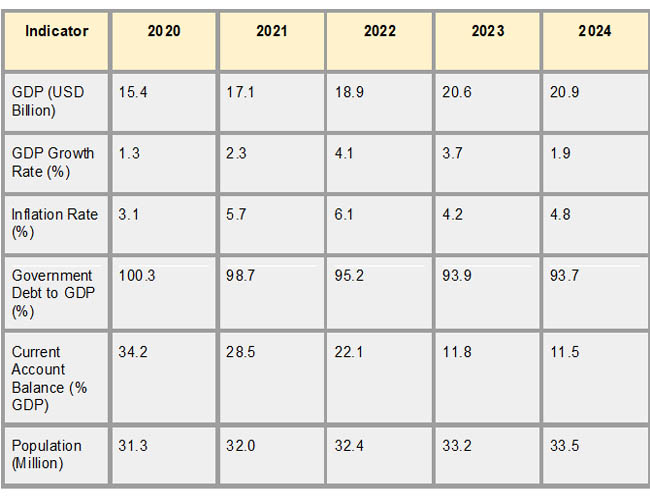
Agriculture, extractive industries, and a developing services sector are the main drivers of Mozambique's economy. Although the nation's economy has advanced significantly in recent years, it is still susceptible to outside shocks like cyclones, changes in the price of commodities, and political unrest. As per Mozambique Import Export Trade Data by Import Globals, the country's GDP improved gradually between 2020 and 2024, increasing from approximately USD 15.4 billion in 2020 to an estimated USD 20.9 billion in 2024. Along with improved export results, this expansion was bolstered by important industries like mining, infrastructure construction, and natural gas exploration.
But economic problems still exist. As per Mozambique Import Customs Data by Import Globals, the nation is still dealing with a significant current account deficit, enormous levels of public debt (over 90% of GDP), and inflationary pressures that average between 4% and 6%. Notwithstanding these challenges, Mozambique's population expansion and calculated investments in LNG projects should maintain the country's long-term economic prosperity. The country's economic picture is also being significantly shaped by government initiatives to increase fiscal stability and draw in foreign direct investment.
Major Export Product Categories of Mozambique
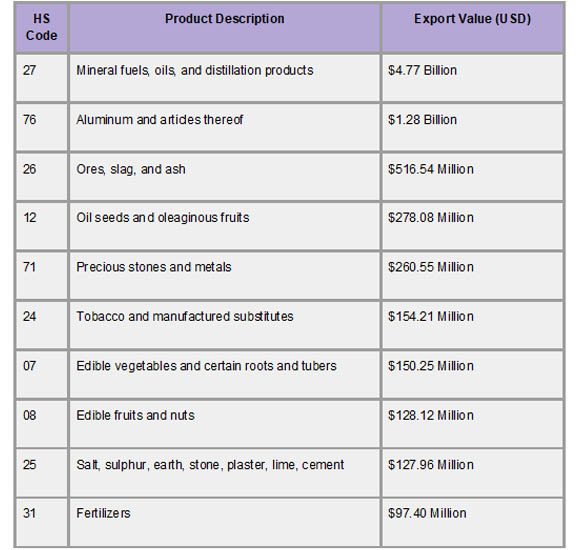
Mozambique’s export structure is heavily dominated by natural resources, particularly mineral fuels and aluminum. As per Mozambique Import Trade Analysis by Import Globals, the largest export category is mineral fuels and distillation products (HS Code 27), primarily liquefied natural gas (LNG), which alone accounted for over $4.7 billion in 2023. This surge is largely due to the development of offshore gas fields and foreign investments in LNG infrastructure. Aluminum and its articles (HS Code 76) form the second-largest export category, contributing around $1.2 billion, mainly from the Mozal aluminum smelter, one of the largest industrial facilities in the country.
Apart from these two industries, Mozambique exports substantial amounts of tobacco (HS Code 24), oil seeds (HS Code 12), precious stones (HS Code 71), ores, slag, and ash (HS Code 26). As per Mozambique Export Data by Import Globals, the nation's abundant mineral and agricultural resources are reflected in these categories. Edible fruits and vegetables, cement and salt, and fertilizers are smaller but expanding export categories that demonstrate the initial phases of product diversification. These exports collectively account for the majority of Mozambique's foreign exchange profits and support industrial development and employment creation in strategic provinces.
Mozambique Export Data
Between 2020 and 2024, Mozambique's export industry grew significantly, supported by the country's growing natural gas sector and rising aluminum output. The overall value of exports increased by 39.76% from 2020, when they were valued at about $4.67 billion, to $6.52 billion in 2021. As per Mozambique Import Data By Import Globals, with exports hitting $9.67 billion in 2022, a 48.25% increase from the year before, this rising trend persisted. The start of LNG exports and the expansion of aluminum production were the main drivers of the rise.
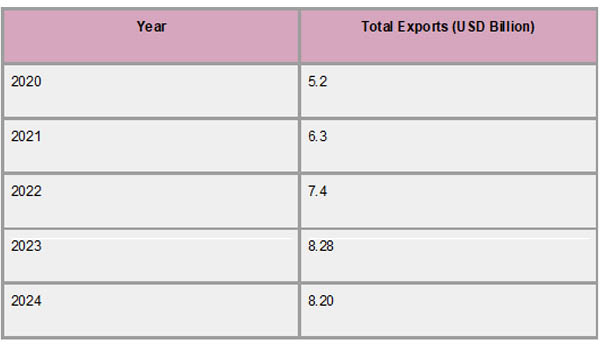
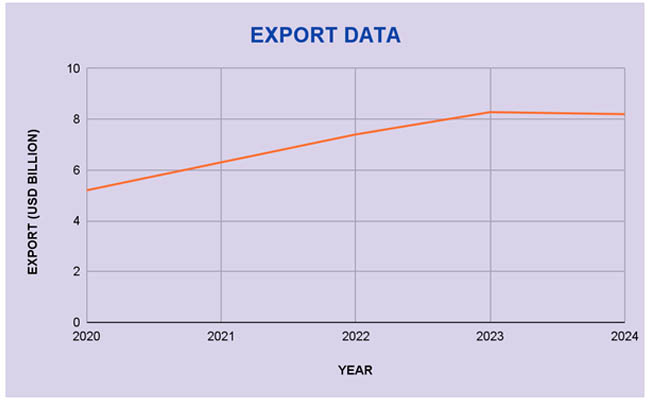
Nevertheless, as per Mozambique Import Trade Statistics by Import Globals, export growth slowed in 2024, with an expected $8.20 billion in total exports. Many causes, including post-election disruptions and unfavorable weather conditions that impact agricultural productivity, were blamed for this downturn. Notwithstanding these obstacles, Mozambique's export industry continues to be an essential part of the country's economy, making a substantial contribution to both economic growth and foreign exchange profits.
Major Export Destinations of Mozambique
With China, South Africa, and India emerging as the main export destinations, Mozambique's export landscape in recent years has been marked by a high reliance on a small number of important foreign markets. As per Mozambique Import Shipment Data by Import Globals, India was Mozambique's top export partner in 2023, contributing almost 15.6% of the country's $1.29 billion in overall exports. The main factor influencing this trade connection is India's importation of coal and natural gas from Mozambique. South Africa came in second, consuming $1.15 billion, or 14.0% of exports, with major imports of coal, power, natural gas, and agricultural goods like bananas. Third place went to China, which imported $1.17 billion, or 14.2% of Mozambique's exports, primarily coal, heavy sands, fruits, oil seeds, and natural gas.
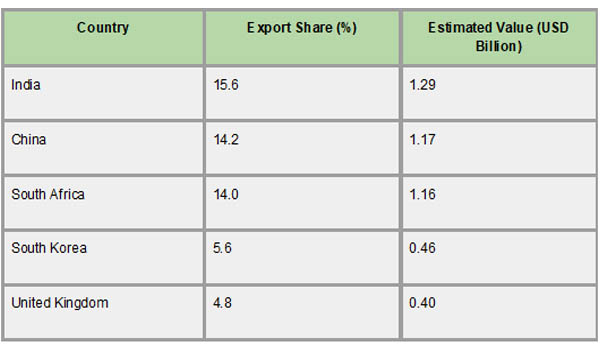

These trade trends persisted in the first half of 2024. With purchases totaling $763.2 million, or 19.8% of Mozambique's exports during this time, India continued to hold its top export destination spot.
As per Mozambique Export Import Global Trade Data By Import Globals, with $617.8 million in imports (16% of exports), South Africa continued to be the second-largest importer, while China rose to 12.2% with $470.7 million in imports. These numbers highlight the three nations' continued relevance in Mozambique's export economy, demonstrating both the strategic value of Mozambique's natural resources in international markets and the country's enduring trading ties.
Top Export Product & Destination
Mineral fuels, especially coal and petroleum gases, are the main drivers of Mozambique's export economy; in 2023, they made up around 41% of all exports from the nation. As per Mozambique Import Export Global Data, petroleum gases contributed $1.72 billion, while coal exports alone were worth $1.76 billion. These numbers, which show large expenditures in the construction of infrastructure and the extraction of natural resources, highlight how important the energy industry is to Mozambique's trading profile.
With imports of $1.29 billion in 2023, or 15.6% of Mozambique's total exports, India has become the country's top export destination. Mineral fuels, oils, and distillation products are the main commodities shipped to India, underscoring the two countries' close energy trading connections. This strong commercial relationship reflects Mozambique's position as a major provider in the global energy market as well as India's expanding energy needs.
Strategic Consequences And Predictions
The export dynamics of Mozambique have important strategic ramifications for the country's economic destiny. The nation's strong reliance on aluminum and mineral fuels makes it susceptible to changes in commodity prices, but it also makes it a vital source of energy, particularly for quickly expanding nations like China and India. More foreign direct investment, especially in LNG and mining infrastructure, may result from this strategic alignment with energy-hungry countries. Mozambique must, however, diversify its export market and deal with structural issues like high public debt and low value-added output if it is to maintain long-term growth. Going forward, Mozambique is in a strong position to increase its export earnings and regional influence through strategic alliances and infrastructure development, provided that political stability and climatic resilience are preserved.
Conclusion
Over the last five years, Mozambique's export industry has grown remarkably, primarily due to the country's rising energy exports and wealth of natural resources. The nation is gradually establishing a significant position in the global export scene, with mineral fuels and aluminum at the forefront, and commercial relations being strengthened with important markets like South Africa and India. Even if there are still issues, such as the need for diversification and economic weaknesses, Mozambique's strategic investments and advancing infrastructure offer a solid basis for long-term export growth and overall economic development in the years to come.
If you are looking for detailed and up-to-date Mozambique Export Data, You Can Contact Import Globals.
FAQs
Que: What are Mozambique's primary export commodities?
Ans: Mozambique's main exports include mineral fuels, aluminum, ores, oil seeds, and precious stones.
Que: Which countries are the largest importers of Mozambican goods?
Ans: The top importers are India, China, South Africa, South Korea, and the United Kingdom.
Que: How has Mozambique's export performance evolved from 2020 to 2024?
Ans: Exports have grown from $5.2 billion in 2020 to an estimated $8.20 billion in 2024, reflecting a positive trend despite economic challenges.
Que: What is the significance of mineral fuels in Mozambique's exports?
Ans: Mineral fuels are the largest export category, contributing approximately 57.6% of total exports in 2023.
Que: How have political and climatic events affected Mozambique's economy?
Ans: Events like post-election unrest and Cyclone Chido have disrupted economic activities, leading to revenue losses and a projected slowdown in growth for 2024.
Que. Where to obtain detailed Mozambique Import Data?
Ans: Visit www.importglobals.com or email info@importglobals.com for more information on up-to-date Mozambique Import Data.
